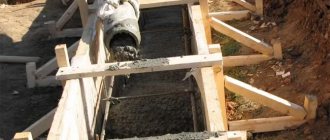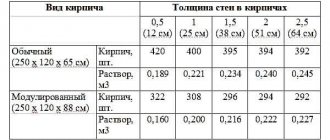When calculating how many cubes of concrete are in a KamAZ mixer, you can find out what the capacity of a concrete mixer truck (concrete mixer truck, concrete truck) is and how many trucks will be needed to transport the volume of concrete required for construction. The need for transportation is determined by the following factors:
- the concrete solution prepared manually at the construction site has worse quality and technical parameters than the one made in a KamAZ mixer at a specialized plant;
- thanks to the concrete mixer, the solution remains homogeneous, does not separate, does not splash, and does not leak along the way from the plant to the construction site.
The main advantages of delivering concrete by mixer
Purchasing and transporting concrete mixture in this way has its advantages:
Convenient delivery and unloading of concrete
- the ability to transport material over long distances without loss of quality;
- the composition is protected from the effects of negative atmospheric factors (sun, temperature changes);
- prompt provision of mortar for both small construction projects and large-scale objects;
- easy, convenient loading and unloading of the mixture from the drum;
- the ability not only to deliver material, but also to fill the structure;
- savings - simultaneously with mixing the solution, it is delivered, which is cheaper than stationary, factory preparation;
- you can buy ready-made, required volume of material;
- built-in strain gauges monitor the level of concrete filling in the mixer and signal about overflow;
- concrete mixture can be transported in dry or liquid state;
- Due to the fact that the drum of the concrete truck constantly rotates, the solution inside does not harden and does not lose quality during transportation.
Correct use of ABS
When ordering a concrete mixer truck, you need to work out the route so that the vehicle does not get stuck off-road. It is necessary to take into account whether the mixer is located high, whether there is a height limit on the road.
Determine one or more unloading points at the site, ensure free access and safe parking. The car is stopped no closer than 8 meters from the edge of the pit, with a slope of no more than 5 0.
Ensure that workers are present to receive the solution. For large volumes of continuous pouring, when placing an order, create an hourly schedule for the delivery of concrete.
The mortar is delivered with a quality certificate and a delivery note.
Features of BSG delivery to remote construction areas
The concrete mixture will not harden under conditions of constant mixing, but the delivered solution will lose strength if the transport arm is too large. Therefore, there are two ways to deliver cargo to the consumer:
- ready mix with RBU;
- loading dry ingredients, mixing with water, in order to prepare a complete mixture on the way.
There is a third way, renting ABS so that it can work on the construction site while active concreting is in progress.
Indicators affecting mixer capacity
The mixing drums of a concrete truck based on the KamAZ chassis have different capacities. The number of cubes of concrete in KamAZ depends on the model of special equipment and the type of its design. KamAZ concrete mixer trucks are produced with drum volumes from 5 to 12 m3.
To supply large construction sites with concrete, special equipment with a capacity of 10–12 m3 is used. It will be difficult for a vehicle with such a tank volume to enter a small-scale construction site.
It is more advisable to use equipment with a mixing drum of 6–9 m3. These standard sizes are the most popular and common among private developers.
The KamAZ mixer has an inclination angle. It can vary from 10 to 15 degrees. Due to the inclined position of the container and internal screw blades, complete, convenient unloading and loading of the solution occurs. The presence of a water tank allows you to wash the tank after each drain of the solution. If this is not done, the remaining concrete will harden on the walls and reduce the amount of “usable” mixture of subsequent deliveries.
Design and principle of operation
The trucks in question are designed to prepare concrete along the route from the point of filling with dry components to the construction site.
Important
Structurally, they are trucks with a special chassis on which a special pear-shaped drum is installed. Sometimes the tank is mounted on separate chassis or semi-trailers.
Structurally, a standard concrete mixer truck consists of the following elements:
- water container;
- loading device where gravel, sand and cement are added;
- drum (mixer);
- drive unit;
- self-loading device.
The pear-shaped concrete container is tilted 10-15 percent for better mixing. Inside there are 2-blade screws that help in stirring the finished mixture. When rotating in one direction, loading occurs, and in the opposite direction, unloading occurs.
Loading/unloading is carried out through special devices. In addition, a water supply system is used to clean the internal cavity and mechanism elements from concrete. Structurally, it consists of a system for creating pressure, dosing and supplying water, as well as storage tanks. In general, all construction mixers in the form of concrete mixer trucks are of two types according to the principle of operation:
- Gravitational. In such devices, the drum has the shape of a pear, and mixing occurs with the help of blades and raising the solution upward. Once the composition is delivered to the limiting level, it falls under the influence of its own weight, and then the cycle repeats.
- Forced. Unlike the type discussed above, the drum does not move. In this case, the working container has the form of a trough/cylinder, and the containers move on a fixed shaft. This allows you to maintain a constant concrete mixing process and greater efficiency.
Domestic concrete mixer trucks differ little in their operating principle and equipment. Such devices can operate in a wide temperature range from -30 to +40 degrees Celsius. In this case, the maximum loading speed when full should not exceed 60 km/h.
Technical characteristics of the capacity of different KamAZ models
The capacity of different models based on KamAZ is presented in the table:
| Specifications | Concrete mixer truck model | ||
| 58147Y | 58149W | 5814W2 | |
| Basic chassis | 6540 8×4 | 65201 6x4 | 65201 8x4 |
| Mixer capacity according to the output of the finished solution, m3 | 7 | 9 | 12 |
| Unloading speed, m3/min | 2–4 / 7–8 | 1 | 1 |
| Unloading height, mm | 2150 | 400–2350 | 360–2310 |
| Loading height, mm | 3570 | 3800 | 3820 |
| Mixer rotation speed, rpm | 0–14 | 0–14 | 0–14 |
| Mixing drum drive type | hydromechanical with power take-off from the chassis engine through the PTO FH 9767 | hydromechanical with power take-off from the chassis engine through the PTO FH 9731 | |
| Water tank capacity, l | 600 | 800 | 800 |
| Gross vehicle weight, kg | 28200 | 33100 | 41000 |
| Curb weight, kg | 12425 | 13825 | 16425 |
| Length, mm | 8050 | 8800 | 10900 |
| Width, mm | 2500 | 2500 | 2550 |
| Height, mm | 3625 | 3800 | 3940 |
All models of KamAZ concrete mixer trucks have different loads, weight parameters and dimensions. The width of the vehicle remains unchanged, which is 2.55 m (large mixers) and 2.50 m (all others).
The volume of the concrete mixer is 7 m³, based on the KamAZ-4310 chassis
Important features to use
The use of automatic concrete mixers should be approached responsibly. You should constantly monitor the cleanliness of the drum; if not regularly maintained, it becomes clogged with concrete and the capacity of the solution decreases. After unloading, the machine must be washed with water; it is advisable to prepare an area where specialists will wash the mixer. Before ordering, it is important to check with suppliers about the volume of the offered machine, because if the amount of the required solution is less, you will end up with an underload and, as a result, a fine.
Return to contents
Calculation options
There are three options for calculating the amount of concrete in the mixer.
Option #1
This calculation is approximate. It is based on the weight of the concrete and requires personal attendance at the plant while the mixing drum is washed and loaded with material.
Before filling a concrete truck, it is weighed (the net weight is determined). After filling, it is weighed again (gross weight). The net is subtracted from the gross and the weight of the loaded material is obtained, which is indicated in the invoice. To calculate the number of cubes of mortar in the mixing drum, it is necessary to divide the mass of concrete (from the invoice) by its density. It happens:
- 1800–2400 kg/m3 – heavy concrete;
- 500–800 kg/m3 – lightweight concrete;
- 500 kg/m3 – ultra-light, foam concrete.
Density of lightweight concrete
Option No. 2
Using this method, you can calculate the amount of mixture and the total load of loaded equipment on the road surface.
One cubic meter of solution weighs on average 2.4 tons, which means that 16.8 tons of concrete (2.4 * 7) will fit into a 7-cubic-meter mixing drum. The weight of an empty concrete mixer truck with a 7 m3 mixer is 12.4 tons (in the table this is the curb weight). The weight of a loaded 7-cc concrete truck will be 29.2 tons (16.8+12.4).
Average dimensions and number of mixer axes depending on volume
Option #3
A cubic meter of concrete mixture is unloaded on average in 10 minutes. It is necessary to note the unloading time and divide the resulting figure by 10. As a result, the number of cubes of solution that was delivered will be obtained.
How to calculate correctly
It is strictly forbidden to turn off the power unit while driving, since the compressor pumping compressed air into the pneumatic brake drive system is switched off. Modern automobile mixers are capable of preparing concrete mixtures of the required grade from pre-loaded components along the route when delivering concrete to the place of use.
Criteria for choosing a concrete mixer
The model range of KamAZ concrete mixer trucks includes more than 20 vehicles. Before choosing a specific model, consider the following:
Example of ABS technical characteristics
- Drum volume. The speed of movement of the concrete mixer, the amount of solution loaded into the mixer, and the load on the road surface depend on this indicator.
- Engine power.
- Patency.
- Full weight of the equipment. Not every large and loaded mixer can travel everywhere.
- Drum rotation speed.
Video: New concrete mixer trucks TZA
Publications on the topic
Determining the proportions of concrete in buckets for a concrete mixer
Design and technical characteristics of the KamAZ-54115 vehicle
Technical characteristics of KamAZ 55111 and the structure of the dump truck cab
Chassis
Modern ABS are equipped with a hydraulic drive of mixing equipment, which replaced the mechanical control method. Mixing after loading is ensured by the rotation of the drum, inside of which spiral blades are located. Unloading is carried out in the forward or backward direction with the reverse movement of the blades. Modern technology delivers the solution to the site at temperatures from -30°C to +40°C.
Volumes of concrete mixer trucks
The most popular on the Russian market is KAMAZ ABS with a volume of 7 cubic meters, followed by 9 cubic meters. The top three are closed by small two-axle mixers based on Japanese right-hand drive trucks with a volume of 2 to 5 cubic meters.
- Preventing spillage of moving concrete during transportation.
- Reducing the load on tires, frame, subframe and chassis ABS.
- The smaller the vehicle’s loading volume, the more passable it is over rough terrain.











